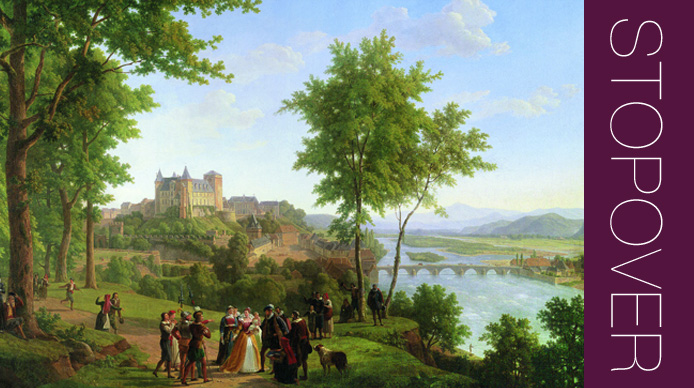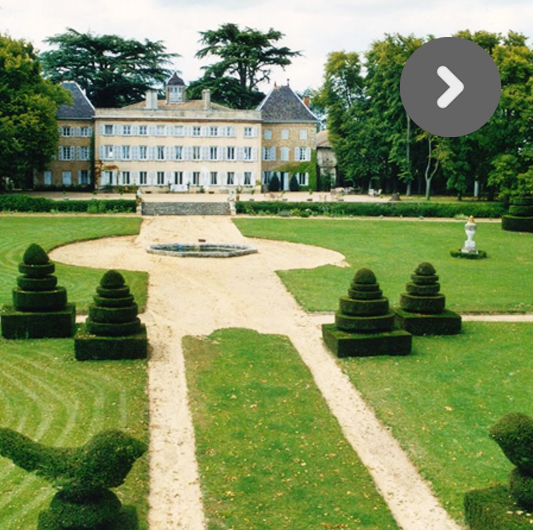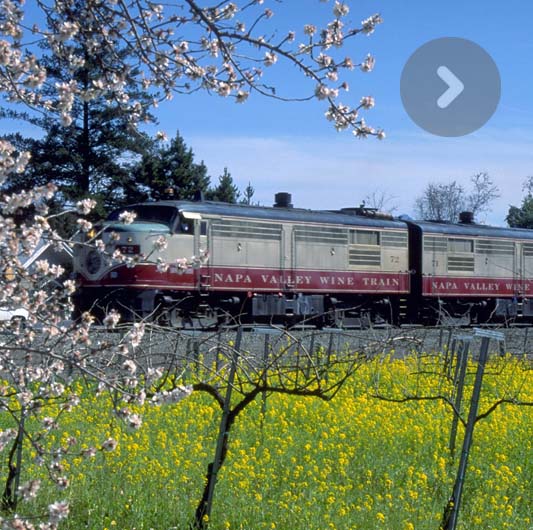
Land and history
Jurançon wines
The Jurançon vineyard, estimated at 1000 hectares, sits between the Gave of Pau and the Gave of Oloron. Overlooking the Pyrenees, the vines seem to run away, over forty kilometres, on hilltops and in valleys, at an average altitude of 300 metres. The vines are pruned to protect them from the rigorous winters. The first written trace of wine trading dates back to the year 988. In 1552, Henry II d’Albret owned a vine in Jurançon, but it is only a year later, at the birth of his grandchild, the future King of France Henry IV, that Jurançon wine entered History.
The cultivation of the vines is carried out in a traditional polyculture landscape. The pastures of the Blonde d’Aquitaine cattle and goats, and the corn fields are increasingly being taken over by viticulture. The Jurançon Controlled Origin Appellation was granted in 1936, the AOC dry Jurançon in 1975 and that of the “Late Harvest” sweet wines in 1996.
Basic grape variety: the gros manseng and the petit manseng, the specific local grape varieties are well adapted to the siliceous-clay ground that is very stony and complemented by the courbu, camaralet and the lauzet grapes varieties that bring out spicy notes. Only as a white wine, the sweet Jurançon is characterised by its amber colour, allying fullness and vivacity with aromas of peach, pear, honey and white flowers. The dry wine is characterised by its golden colour with green highlights and fresh aromas of broom flowers and acacia that draw on toast and dry fruit as they age.
Pau
Pau remained the capital of the Kingdom of Navarre up until the eighteenth century. The Béarn region was only brought under the French crown under Louis XIII. The city of Pau boasts an illustrious child, the son of Antoine de Bourbon and Jeanne d’Albret, the future King of France, Henri IV. First in line of the Bourbon family line, the young Henry of Navarre was born at the Château de Pau in December 1553. At his baptism, his lips were rubbed with a clove of garlic soaked in Jurançon wine: a Royal custom to bring strength and courage that still runs today. What it also did was give the King’s favourite wine its repute! In the nineteenth century, the boulevard des Pyrénées was remodelled to look like the Promenade des Anglais. The white crest of the Pyrenees Mountains and the Pic du Midi at Ossau replace the waves of the Great Blue (sea). A golf course, casino, horse racing, concert hall, fresh air and good fare… As early as the late nineteenth century, Pau became a sought after resort for the Brits. In 1850, one out of thirteen inhabitants of Pau wasn’t French!
The Emir Ab Del Kader was held prisoner in Pau until his death. One can admire the Observatory that he had installed to escape towards the sky every night, above one of the buildings Place Royale.
The Château. A visit of the château takes one through nine centuries of History. The Château in Pau was the fortress of the viscounts of Béarn, a fortified castle under the sovereignty of Gaston Fébus and a Royal residence at the Renaissance. Despite all that, the inhabitants of Pau still see it as good King Henry’s castle. One of the highlights of the visit is the lavishly decorated bedroom with Henry’s cradle made out of a tortoise shell and the huge dining Room of the Hundred Covers, where his statue is proudly displayed at the end of the table. The guided visit lasts 1.5 hours. Tel.: + 33 5 59 82 38 07. www.musee-chateau-pau.fr
The House of Bernadotte. Jean-Baptiste Bernadotte was born on 26 January 1763 in this plain and typical eighteenth century house. The Revolution will grant this fifth child from a modest family an extraordinary destiny. A simple sergeant, made brigade general, he fought in Napoleon’s army and was became an ambassador. Bernadotte will later be made a Marshal of the Empire. The Swedes liked him so much; they made him King in 1818 following the death of their King Charles XIII. His descendants continue to reign over Sweden. 8 rue Tran. Tel.: +33 5 59 27 48 42
The Beaumont Palace.A Winter Palace built in 1900 to meet the demands of the rich foreign clientele. It contains a casino and a conference centre. The recent renovation, to be attributed to the architect François Lombard, integrated the neo-classical façades and the original “patisserie” ornaments.
The Fine Art Museum. The museum, whose architecture is both classical and modern, boasts a vast permanent collection of paintings from the Flemish, Italian, French and Spanish schools from the fifteenth to the twentieth centuries. Regional painters such as Galos, Poumeyrol, Laborde are also well represented. Rue Mathieu Lalane. Tel.: +33 5 59 27 33 02
![]()
The Bistrot d’à Côté. Its long dining room with moleskin benches and waxed wooden tables reminds us of the town’s smart brasserie. Regulars come and enjoy a glass of wine at the zinc counter. Others, whilst enjoying the welcome soup, scour the slate board for their favourite dish. 1 Place Gramont. Tel.: +33 5 59 27 98 08
Ze Bistrot.It’s “ze” place to be. In Pau’s historic quarter, a friendly mood reigns over Thierry and Laurence Lassala’s restaurant every evening. While uncorking a bottle of Jurançon or Madiran recommended by the landlord, one happily tucks into a dish of garbure béarnaise or other specialities that honour Gascony cuisine. Open Tuesday to Friday. 13 rue Henri IV. Tel: +33 5 59 27 44 44
La Cantine O Berry. With its typical décor, this canteen in Pau has been a trendy spot for the last 40 years for any amateur of compelling foods. The menu includes impressive cuts of beef, andouillette and sometimes Poule au Pot. One is never disappointed! 4 rue Gachet. Tel.: + 33 5 59 27 42 95
Biraben. A house of tradition since 1946 that produces duck and goose foie gras and confits. On the shelves, pots of garbure, cassoulet and tarbais beans stare at you softly. Difficult to resist such delicious things. Market Hall, Pau. Tel.: +33 5 59 27 50 78 www.biraben.fr
Alexandre’s Fromagerie. His stall is buried under all the creamy fresh cheeses, the range of hard cheeses (tommes) from the Aspe valley, the AOC Ossau Oraty sheep’s cheese…One doesn’t know which to choose. Alexandre Salle’s cheeses are all local and matured at the farms. One is compelled to choose an assortment. They are delightful with a glass of dry Jurançon. Market Hall, Pau. Stall number 5. Tel.: +33 5 59 27 86 32
Au Parapluie des Pyrénées. The very last house to manufacture the original large Berger umbrella. Hervé and his son, Christophe Pando, uphold this beautiful tradition. High fashion umbrellas that are handmade with the greatest care. Beechwood handles, rattan boning, waterproof cotton canvas, enough to protect you from rain showers till the end of your life. 12 rue Montpensier. Tel.: +33 5 59 27 53 66
Bord de Gave. The only béarnaise sauce to still be made in the Béarn according to Samuel Sebban. The famous sauce was in fact invented in the nineteenth century in Saint-Germain en Laye at Henri IV’s pavilion, even though the inhabitants of the Béarn appropriated it for themselves! The grocery, dedicated to the Béarnaise sauce, also leaves some room for other good local products from the Basque and Béarn regions. 4 rue Jeanne d’Albret. Tel.: + 33 5 47 92 52 00. www.bord-de-gave.fr
The Couronne’s chocolates. With his exquisite “Golden pearls”, “Cherries” and “The Swedes”, the master chocolatier Laurent Chagneau has seduced the palates of each inhabitant in Pau including General de Gaulle’s. His “Créoles”, ganache with champagne, were so appreciated by the General that he would have them delivered straight to the Élysée. His latest creation “The Palet des Pyrénées”, chocolate flavoured with butter and a touch of salt from Salies-de-Béarn, will make you melt. 20 Palais des Pyrénées www.chocolat-pau.com
Villa Navarre. A nineteenth century country residence built in the middle of a four hectare park for Auguste Guillemain. It was part of the string of private villas where the English way of life took precedence. The villa used to be Frederic Beigbeder’s family residence before its transformation into a charming hotel and restaurant by Patrick de Stampa. Nicknamed “The house of books”, it was where Jean Cocteau, René Benjamin and the poet Jean Paul Toulet would come and find some rest. One can now stay there or simply enjoy a glass of wine at the bar under the arched ceilings and wood panelling of the old chapel. 59 avenue Trespoey. Tel.: + 33 5 59 14 65 65. www.villanavarre.fr
Land and History
The wines of the Jurançon
The Jurançon vineyard, estimated at 1000 hectares, sits between the Gave de Pau and the Gave d’Oloron. Overlooking the Pyrenees, the vines seem to run away, over forty kilometres, over hilltops and into valleys, at an average altitude of 300 metres. The vines are pruned to protect them from the rigorous winters. The first written trace of wine trading dates back to the year 988. In 1552, Henry II d’Albret owned a vine in Jurançon, but it is only a year later, at the birth of his grandchild, the future King of France Henry IV, that Jurançon wine enters History.
The cultivation of the vines is carried out in a traditional polyculture landscape. The pastures of the Blonde d’Aquitaine cattle and goats, and the corn fields are increasingly being taken over by viticulture. The Jurançon Controlled Origin Appellation was granted in 1936, the AOC dry Jurançon in 1975 and that of the “Late Harvest” sweet wines in 1996. Basic grape variety: the gros manseng and the petit manseng, the specific local grape varieties are well adapted to the siliceous-clay soil that are very stony and complemented by the courbu, camaralet and the lauzet that bring out spicy notes. Only as a white wine, the sweet Jurançon is characterised by its amber colour, allying fullness and vivacity with aromas of peach, pear, honey and white flowers. The dry wine is characterised by its golden colour with green highlights and fresh aromas of broom flowers and acacia that draw on toast and dry fruit as they age.










